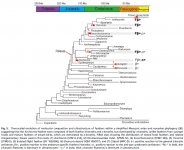Fred Ruhe
Well-known member

Yanhong Pan, Wenxia Zheng, Roger H. Sawyer, Michael W. Pennington, Xiaoting Zheng, Xiaoli Wange, Min Wang, Liang Hu, Jingmai O’Connor, Tao Zhao, Zhiheng Li, Elena R. Schroeter, Feixiang Wu, Xing Xu, Zhonghe Zhou and Mary H. Schweitzer, 2019
The molecular evolution of feathers with direct evidence from fossils
Proceedings of the National Academy of Sciences of the United States of America. in press. doi:10.1073/pnas.1815703116
Significance
During the dinosaur–bird transition, feathers of bird ancestors must have been molecularly modified to become biomechanically suitable for flight. We report molecular moieties in fossil feathers that shed light on that transition. Pennaceous feathers attached to the right forelimb of the Jurassic dinosaur Anchiornis were composed of both feather β-keratins and α-keratins, but were dominated by α-keratins, unlike mature feathers of extant birds, which are dominated by β-keratins. Data suggest that the pennaceous feathers of Anchiornis had some, but not all, of the ultrastructural and molecular characteristics of extant feathers, and may not yet have attained molecular modifications required for powered flight.
Abstract
Dinosaur fossils possessing integumentary appendages of various morphologies, interpreted as feathers, have greatly enhanced our understanding of the evolutionary link between birds and dinosaurs, as well as the origins of feathers and avian flight. In extant birds, the unique expression and amino acid composition of proteins in mature feathers have been shown to determine their biomechanical properties, such as hardness, resilience, and plasticity. Here, we provide molecular and ultrastructural evidence that the pennaceous feathers of the Jurassic nonavian dinosaur Anchiornis were composed of both feather β-keratins and α-keratins. This is significant, because mature feathers in extant birds are dominated by β-keratins, particularly in the barbs and barbules forming the vane. We confirm here that feathers were modified at both molecular and morphological levels to obtain the biomechanical properties for flight during the dinosaur–bird transition, and we show that the patterns and timing of adaptive change at the molecular level can be directly addressed in exceptionally preserved fossils in deep time.
Enjoy,
Fred
Phylogenetic position of Anchiornis
The molecular evolution of feathers with direct evidence from fossils
Proceedings of the National Academy of Sciences of the United States of America. in press. doi:10.1073/pnas.1815703116
Significance
During the dinosaur–bird transition, feathers of bird ancestors must have been molecularly modified to become biomechanically suitable for flight. We report molecular moieties in fossil feathers that shed light on that transition. Pennaceous feathers attached to the right forelimb of the Jurassic dinosaur Anchiornis were composed of both feather β-keratins and α-keratins, but were dominated by α-keratins, unlike mature feathers of extant birds, which are dominated by β-keratins. Data suggest that the pennaceous feathers of Anchiornis had some, but not all, of the ultrastructural and molecular characteristics of extant feathers, and may not yet have attained molecular modifications required for powered flight.
Abstract
Dinosaur fossils possessing integumentary appendages of various morphologies, interpreted as feathers, have greatly enhanced our understanding of the evolutionary link between birds and dinosaurs, as well as the origins of feathers and avian flight. In extant birds, the unique expression and amino acid composition of proteins in mature feathers have been shown to determine their biomechanical properties, such as hardness, resilience, and plasticity. Here, we provide molecular and ultrastructural evidence that the pennaceous feathers of the Jurassic nonavian dinosaur Anchiornis were composed of both feather β-keratins and α-keratins. This is significant, because mature feathers in extant birds are dominated by β-keratins, particularly in the barbs and barbules forming the vane. We confirm here that feathers were modified at both molecular and morphological levels to obtain the biomechanical properties for flight during the dinosaur–bird transition, and we show that the patterns and timing of adaptive change at the molecular level can be directly addressed in exceptionally preserved fossils in deep time.
Enjoy,
Fred
Phylogenetic position of Anchiornis
Attachments
Last edited:




